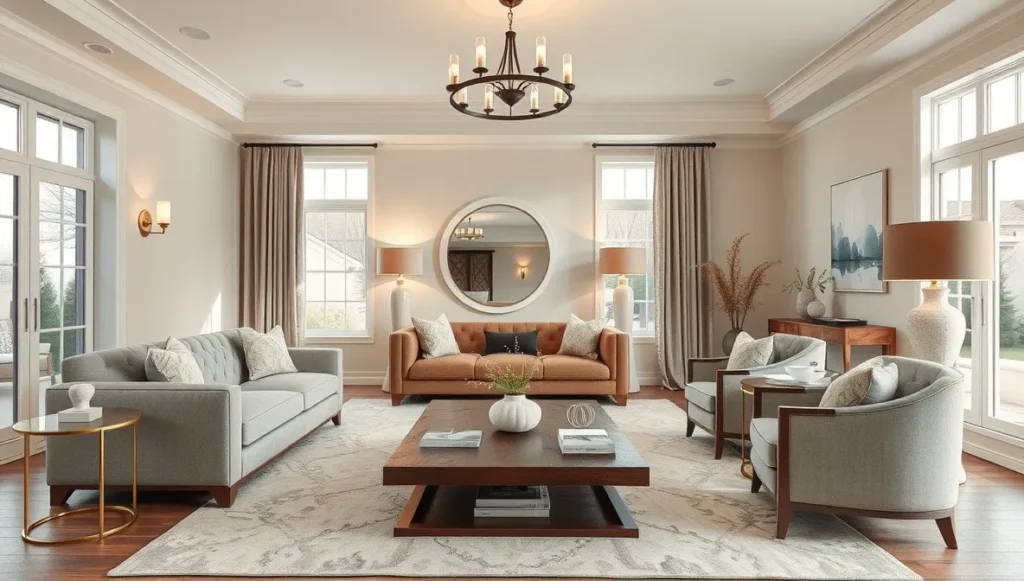Introduction
Transitional interior design is the perfect balance between classic elegance and modern simplicity. It merges traditional and contemporary styles, creating a timeless yet fresh aesthetic for your home. This ultimate guide will walk you through the key elements, furniture choices, color palettes, and expert tips to achieve the perfect transitional home design effortlessly.
If you love the warmth of traditional decor but appreciate the sleekness of modern design, then transitional interiors are for you! Let’s explore how you can create a stunning transitional style home that exudes comfort, sophistication, and harmony.
What is Transitional Interior Design?
Transitional interior design is a hybrid style that combines traditional and contemporary elements for a sophisticated yet comfortable look. It blends the best of both worlds:
- Traditional Elegance – Classic furniture, warm tones, and detailed craftsmanship.
- Modern Simplicity – Clean lines, neutral colors, and minimal ornamentation.
This style is ideal for those who want a timeless aesthetic that isn’t overly ornate or too minimalistic. It’s about balance, harmony, and effortless style.
Key Characteristics of Transitional Interiors:
- Neutral Color Palettes – Whites, grays, beiges, and soft earth tones.
- Balanced Furniture – A mix of modern and classic furniture pieces.
- Minimal Decorative Elements – Less clutter, more statement pieces.
- Soft Textures – Plush rugs, cozy throws, and upholstered furniture.
- Elegant Lighting – Chandeliers, sconces, and sleek modern lamps.
How to Achieve a Stunning Transitional Home Design
1. Transitional Living Room Design
A transitional living room is welcoming, comfortable, and elegantly balanced.

- Furniture: Choose a neutral-toned sofa with a mix of modern and traditional armchairs. Opt for a glass or wooden coffee table for sophistication.
- Color Palette: Stick to soft, warm tones like beige, gray, or taupe, and introduce contrast with dark wood or deep blue accents.
- Textures & Patterns: Incorporate textured throw pillows, woven rugs, and layered curtains for depth.
- Lighting: A chandelier or modern pendant lights provide the perfect mix of classic and contemporary.
- Decor Elements: Use a large statement mirror, minimalistic artwork, and curated bookshelves to maintain balance.
2. Transitional Bedroom Design
A transitional bedroom should be calm, relaxing, and effortlessly stylish.

- Bed Frame: Opt for a tufted headboard or a wooden bed frame with soft upholstery.
- Bedding & Fabrics: Use neutral linens, layered throw blankets, and accent pillows for warmth.
- Furniture: Choose sleek nightstands with brass or wooden finishes.
- Lighting: Install table lamps with fabric shades, or opt for sconce lighting for a soft ambiance.
- Wall Decor: Consider framed artwork, abstract paintings, or botanical prints for elegance.
3. Transitional Kitchen & Dining Room Design
A transitional kitchen and dining space blends classic materials with modern touches.

- Cabinetry & Finishes: Opt for shaker-style cabinets in white, gray, or navy with sleek hardware.
- Countertops & Backsplash: Use quartz, marble, or subway tiles for an elegant look.
- Dining Furniture: A wooden dining table paired with upholstered or metal-framed chairs.
- Lighting: Hang pendant lights or a modern chandelier above the dining table.
- Decor Accents: Add ceramic vases, simple floral arrangements, and subtle wall art.
4. Transitional Bathroom Design
A transitional bathroom focuses on clean aesthetics and timeless appeal.

- Tiling: Use subway tiles, marble, or soft mosaic flooring.
- Vanity & Sink: Choose a wood or white vanity with brushed nickel or matte black hardware.
- Mirrors & Fixtures: Opt for framed mirrors with modern yet classic detailing.
- Storage & Accessories: Use woven baskets, soft towels, and minimalistic shelves.
5. Transitional Home Office Design
A transitional home office should be functional, stylish, and free of clutter.

- Desk & Chair: Choose a distressed wood or sleek modern desk with a comfortable, upholstered chair.
- Storage: Use bookshelves, filing cabinets, and decorative storage boxes to keep things tidy.
- Lighting: Install task lighting with elegant table lamps or sleek pendant lights.
- Wall Decor: Incorporate framed artwork, minimalist shelving, and an inspiration board.
How to Achieve a Transitional Look on a Budget
Creating a transitional home design doesn’t have to be expensive. Here’s how to achieve the look affordably:
- DIY Distressed Furniture – Use chalk paint and sandpaper to give furniture a classic touch.
- Thrift Store Finds – Search for vintage furniture, mirrors, and light fixtures.
- Affordable Linens & Textiles – Choose cotton, linen, and soft fabric upholstery.
- Peel & Stick Wallpaper – A budget-friendly way to add transitional charm.
- Mix New & Old – Combine modern furniture with traditional decor to balance the look.
FAQs About Transitional Interior Design
1. What’s the difference between transitional and contemporary design?
Contemporary design is purely modern, while transitional design blends modern with classic elements for a timeless appeal.
2. Can transitional design work in small spaces?
Absolutely! Use neutral tones, multi-functional furniture, and minimal decor to keep the space airy and open.
3. What furniture works best in a transitional-style home?
- Tufted sofas & upholstered chairs
- Glass & wooden coffee tables
- Statement chandeliers & sleek floor lamps
- Shaker-style cabinets in kitchens
4. Is transitional style expensive?
Not necessarily! Mix high-end pieces with budget-friendly finds, and focus on quality over quantity.
Final Thoughts
Transitional interior design is the perfect way to balance tradition and modernity while maintaining elegance and comfort. By incorporating neutral colors, mixed textures, classic-meets-modern furniture, and minimalist decor, you can create a stunning transitional-style home that feels both timeless and inviting.
Are you ready to transform your home into a beautiful transitional retreat? Let us know your favorite transitional decor ideas in the comments below!
